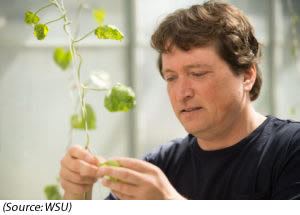
Biologist Finds Way for New Approaches to Fight Plant Disease
June 8, 2016| |
 Washington State University (WSU) biologist Michael Knoblauch has found what he calls a very strong support for an 86 year-old hypothesis about how nutrients move through plants. According to Knoblauch, 90 percent of the food we consume at one time went through a plant's phloem, where they are produced by photosynthesis, to roots and fruits. But scientists know so little about how this works.
Washington State University (WSU) biologist Michael Knoblauch has found what he calls a very strong support for an 86 year-old hypothesis about how nutrients move through plants. According to Knoblauch, 90 percent of the food we consume at one time went through a plant's phloem, where they are produced by photosynthesis, to roots and fruits. But scientists know so little about how this works.
Knoblauch has spent more than 20 years devising ways to look inside a living plant without disrupting the processes he was trying to measure and describe. He measured flow velocities with fluorescent dyes and radioactive isotopes, and developed a "picogauge" that could measure extremely sensitive phloem pressures. Using several microscopes, he measured the circumferences of not only plant stems, but the ciabatta-like holes of sieve plates that separate elongated cells in the phloem tissue. The cell geometries were particularly critical, as an order-of-magnitude change in the diameter of a tube or hole creates a four-order change in the volume delivered to the roots or fruits.
Knoblauch hopes that his work will result in new ways to protect plants, aside from building the evidence for a long-help hypothesis.
For more details, read the news release about the research in WSU News.
| |
Biotech Updates is a weekly newsletter of ISAAA, a not-for-profit organization. It is distributed for free to over 22,000 subscribers worldwide to inform them about the key developments in biosciences, especially in biotechnology. Your support will help us in our mission to feed the world with knowledge. You can help by donating as little as $10.
-
See more articles:
-
News from Around the World
- Researchers Crack Genome that May Lead to Development of Allergen-free Peanuts
- Oxford University Scientists Discover Oldest Root Meristem
- Biologist Finds Way for New Approaches to Fight Plant Disease
- CropLife Reports 20 Years of GM Crop Benefits in Australia
- Plants Remember Previous Stress to Help Protect Themselves
- Silenced Susceptibility Genes in Potato Result in Late Blight Resistance
- Scientists Discover Protein which Boosts Rice Yield by 50 Percent
-
Research Highlights
- Scientists Modify Bt Toxin to Improve Activation in Pea Aphid Gut
- Rol Genes Enhance Production of Antioxidants in Artemisia carvifolia
- NtTTG2 Gene Regulates Tobacco Growth and Seed Production via AUXIN RESPONSIVE FACTOR Genes
-
Beyond Crop Biotech
- Genomes of Wild Parents Reveal Complex History of Garden Petunias
- Chemists and Biologists Make Bionic Leaf That Produces Alcohol Fuel
- University at Buffalo Researchers Develop Vaccine that Strikes Only When Needed
-
Announcements
- CAFEi2016
-
Resources
- Feeding the World in Future: Where Does GM Fit in?
-
Read the latest: - Biotech Updates (December 17, 2025)
- Gene Editing Supplement (December 17, 2025)
- Gene Drive Supplement (February 22, 2023)
-
Subscribe to BU: - Share
- Tweet
